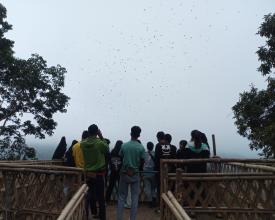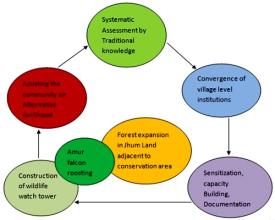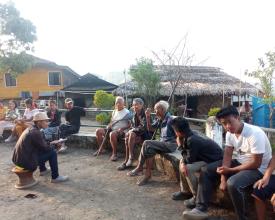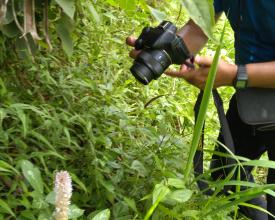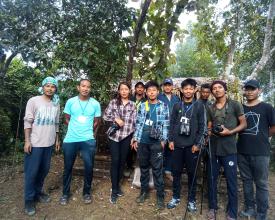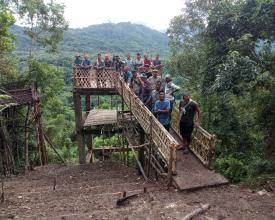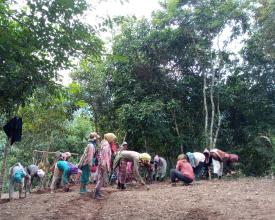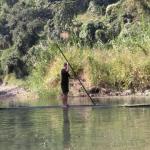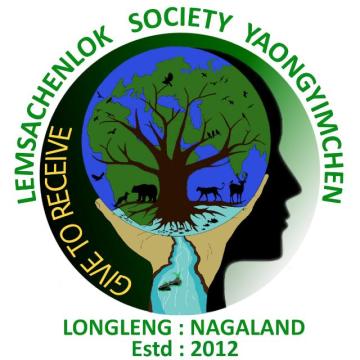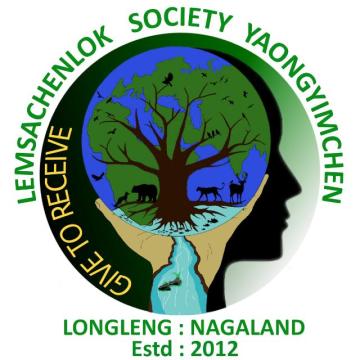
Effective Community Participation in Biodiversity Conservation Strategies
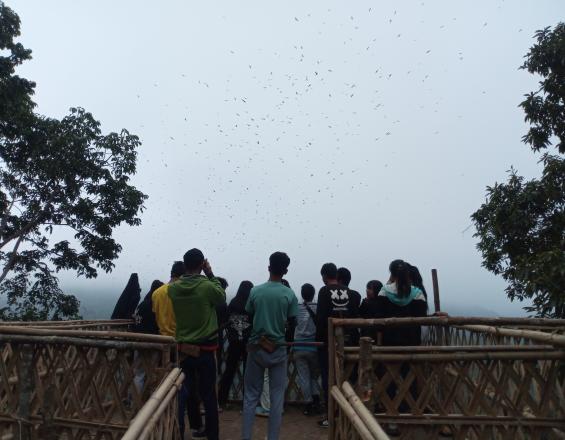
This solution presents successful regeneration of forest and wildlife through active participation of grass root level community members in biodiversity conservation measures.
It involves the realization of the forest degradation and loss of wild species by sensitizing community members about the impending fallout of the ecosystem and the urgent need to care for Mother Earth and sustainable use of natural resources. This way various grass root level institutions come together for a global cause.
Communities actively participate in the effective implementation of strategies for biodiversity conservation, including forgoing a Jhum cultivation cycle in the forest land adjacent to Biodiversity Conservation Area to expand the forest cover.
Context
Challenges addressed
Environmental challenges:
- Exploitation of the forest and its products
- Deforestation for Jhum cultivation
- Hunting wildlife for consumption and economic gain
Social challenges:
- Forest boundary disputes are reduced/solved by introducing the concept of a joint Biodiversity Conservation Area by warring neighbour villages fulfilling peace in harmony with nature
Economic challenges:
- Forest dependent communities are given alternative livelihood support through income generating activities such as piggery and ginger farming to augment their livelihood production and ensure economic sustenance
Location
Process
Summary of the process
Please see the graphic below to understand the interaction.
Building Blocks
Ecosystem Vulnerability Assessment through Traditional Knowledge
One of the keys to identifying habitat loss is through traditional means. During the olden days, the naming of any species happened due to its presence/sightings. But presently, most of the species that have local names are not found in the wild. One of the reasons could be that their numbers are declining or may even have become extinct. Therefore, through the approach of traditional knowledge, species availability and vulnerability assessments can be made.
Enabling factors
Elders have an indispensable role in the community. For generations, they have been the source of wisdom and knowledge of various traditions and cultural practices, including those associated with nature. Using such traditional wisdom is an essential asset for many issues that often pave the way for possible interventions. Thus, building a good rapport with the elders, and creating a space for sharing and learning with them, is one of the strengths of the process.
Lesson learned
- The elders are old but wise; make friends with them and gain knowledge.
- Relying only on theoretical knowledge is not sufficient. Therefore, strolling around the jungle with the elders and listening to various sounds of birds and animals has more practical relevance and creates bonding with nature.
Convergence of Village Level Institutions
Each village is known to have a distinct set of rules and functions for social coexistence. The village community is composed of various groups that function independently to manage certain areas for their welfare in the community. However, for a common cause such as Biodiversity Conservation initiatives, these various institutions can be converged and function as a single entity.
Enabling factors
- A community willing to learn and accept ideas relevant to promote sustainability growth.
- Building a good relationship with the community.
- A genuine intention of the working members to contribute to a global cause.
Lesson learned
It is possible to make things happen if there is a genuine intention.
Sensitization, Capacity Building and Field Survey for Data Collection and Monitoring
Lack of awareness due to poor sensitization is often the main reason for little understanding of environmental issues. Sharing proper information supported by valid scientific/practical proof will convince communities that are unfortunately less educated, economically deprived and directly forest dependent. Equip them not only with true information but also with tools such as camera trapping, and support for species identification and naming. Such an approach will develop a sense of belonging and inculcate ownership of the cause/purpose.
Enabling factors
Realization of the need for a common cause at the local level with broader implications.
Lesson learned
To make a connection with nature and the environment, our activities - wherever possible - are carried out in close association with nature. Seminars and other capacity building activities can be conducted in the jungle to create a real-time experience in nature and connect with its rich floral and faunal resources.
Construction of Innovative Watch Tower
For many years, the Biodiversity Conservation initiative created a favourable environment and healthy ecosystem in the area. As a result, the migrating Amur falcons saw the area as a haven for roosting. The communities continue to provide a suitable environment for these visiting raptors. With many tourists visiting to see the Amur falcon roosting, the community constructed an innovative wildlife Watch Tower in strategic locations to provide a beautiful view of the roosting falcons.
Enabling factors
A Community willing to learn and accept ideas relevant to the present context and at the same time also voluntarily contribute their own resources and time whenever necessary.
Lesson learned
Working together as a community can be a learning experience and many great things can be achieved through teamwork with limited available resources.
Assisting the Community: Alternative Livelihood Measures
With the forest left undisturbed, forest-dependent communities have few options for their livelihood sustenance. Therefore, the LEMSACHENLOK Society started to introduce alternative livelihood measures for the economically downtrodden. Income generation activities such as piggery promotion, ginger plantation, packaging and sale of certain products are initiated on our own small scale.
Enabling factors
Acceptance of one’s specific role in a community-initiated work. We needed to prepare for possible livelihood alternatives, even including contributions from our own organisation. The Society’s management team had extended economic assistance by integrating income generation activities.
Lesson learned
Global communities should recognize the indigenous communities that are involved in nature conservation, and facilitate to empower them to be an agent of change towards creating a healthy sustainable environment.
Impacts
Environmental impact:
- Regular sightings of wild animals and their documentation by camera trapping
- Rich floral resources including plants with various ornamental and medicinal values are documented
- The migratory bird Amur falcon began roosting in the Biodiversity Conservation Area and the local community members continue to welcome and host the visiting guest birds annually
- The number of roosting falcons is estimated to be increasing every year
Social impact:
- Communities work together for the cause of biodiversity conservation which serves as a binding factor for community members from different clans and age groups
- Roosting of Amur falcon brings people from various cultures and fields together to document, research and witness the beautiful sights of falcons roosting in the area
Economic impact:
- The initiative has promoted the community to shift towards creating a Nature-based recreational area in their forest for income generation
Beneficiaries
- Indigenous community
- The Solution also benefits global communities through participation in an effort to create an improved ecosystem
Sustainable Development Goals
Story
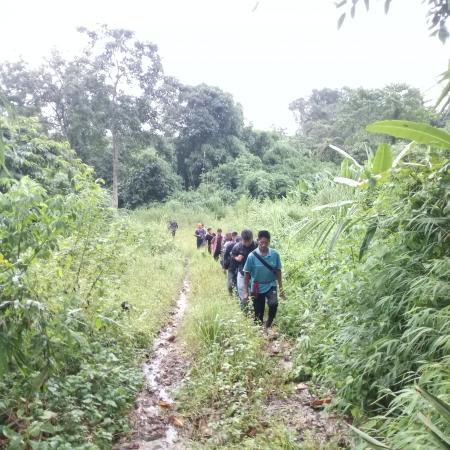
Y Nuklu Phom was born in Yaongyimchen, a small village in the Eastern part of Nagaland, located in North-East India. An ardent lover of nature, having witnessed the dramatic loss of biodiversity, Y Nuklu Phom started to associate with the community in his ancestral village to establish a Community Biodiversity Conservation project. He spent years with the elders of Yaongyimchen, Alayong and Sanglu village and could convince them to set aside around 15 sq.km of forest to allow the biodiversity of that area to thrive without any human interference. His innovative concepts such as a practical approach for transition from 'Shooting with Guns to Shooting with Camera' was very effective. The conservation effort has been a great success. His work has been globally recognized and was awarded the prestigious Whitley Fund for Nature in 2021.

